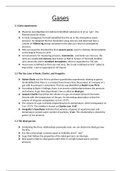Summary
Summary Gases
Summary of 5th chapter from Chemical Principles: Zumdahl and Decoste. Notes containing key concepts from the chapter and thorough explanations of the terminology. Also includes formulas and relevant course-related information.
[Show more]



